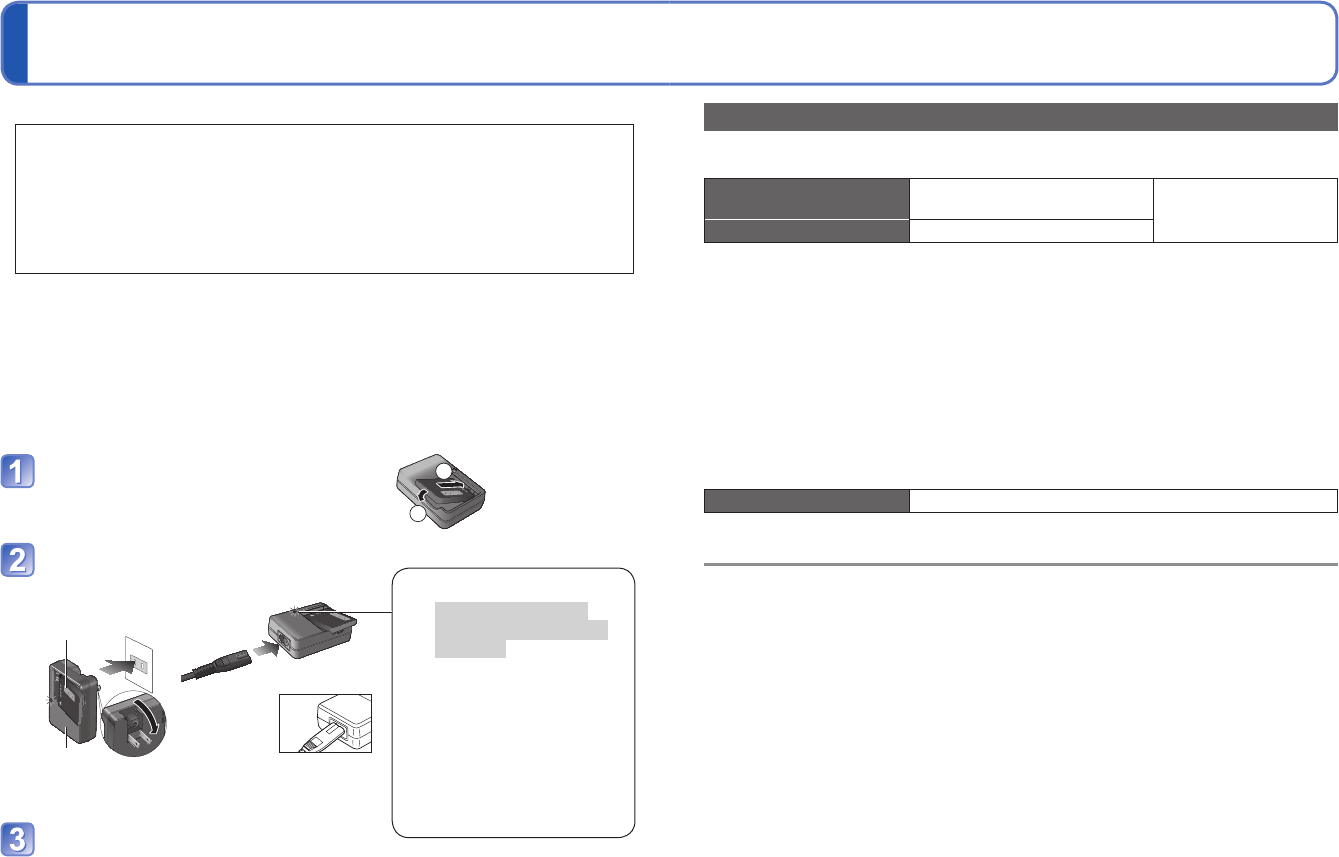
8 VQT2M98 VQT2M98 9
Always charge before first use! (not sold pre-charged)
Charging battery
■
About batteries that you can use with this unit
It has been found that counterfeit battery packs which look very similar to the
genuine product are made available to purchase in some markets. Some of
these battery packs are not adequately protected with internal protection to
meet the requirements of appropriate safety standards. There is a possibility
that these battery packs may lead to fire or explosion. Please be advised that
we are not liable for any accident or failure occurring as a result of use of
a counterfeit battery pack. To ensure that safe products are used we would
recommend that a genuine Panasonic battery pack is used.
• Use the dedicated charger and battery.
• The camera has a function for distinguishing batteries which can be used
safely. The dedicated battery supports this function. The only batteries
suitable for use with this unit are genuine Panasonic products and batteries
manufactured by other companies and certified by Panasonic. (Batteries which
do not support this function cannot be used). Panasonic cannot in any way
guarantee the quality, performance or safety of batteries which have been
manufactured by other companies and are not genuine Panasonic products.
Insert the battery terminals and
attach the battery to the charger
Ensure [LUMIX] faces outwards.
Connect the charger to the
electrical outlet
●
Plug-in type
●
Inlet type
Battery
(model- specific)
Charger
(model - specific)
Detach the battery after charging is
completed
Charging light ([CHARGE])
On: Charging in progress
(approx. 110 min. if fully
depleted)
Off: Charging complete
If light is flashing:
• Charging may take longer
than normal if battery
temperature is too high or
too low (charging may not be
completed).
• Battery/charger connector is
dirty. Clean with a dry cloth.
• The AC
cable does
not fit
entirely into
the AC input
terminal. A gap will remain.
Guidelines for number of recordable pictures and recording time
Figures may be reduced if flash, zoom, or [LCD MODE] are used frequently; or in colder
climates.
Number of recordable
pictures
Approx. 300 pictures
By CIPA standard
Recording time Approx. 150 min
●
Recording conditions by CIPA standard
• CIPA is an abbreviation of [Camera & Imaging
Products Association].
• [NORMAL PICTURE] Mode.
• Temperature: (23°C (73.4 °F))/Humidity: 50%
when LCD monitor is on.
∗
• Using a Panasonic SD Memory Card (32
MB).
• Using the supplied battery.
• Starting recording 30 seconds after the
camera is turned on. (When the optical image
stabilizer function is set to [AUTO].)
• Recording once every 30 seconds with full
flash every second recording.
• Rotating the zoom lever from Tele to Wide or
vice versa in every recording.
• Turning the camera off every 10 recordings
and leaving it until the temperature of the
battery decreases.
∗
The number of recordable pictures
decreases in Auto Power LCD Mode and
Power LCD Mode.
Number reduced if intervals longer – e.g. to approx. one quarter (75 pictures) for 2-minute intervals
under the above conditions.
Playback time Approx. 260 min
The number of recordable pictures or available recording time may vary slightly according
to battery and usage conditions.
●
The time required for charging varies depending on conditions of battery usage. Charging takes
longer at high or low temperatures and when the battery has not been used in some time.
●
Battery will be warm during charging and for some time thereafter.
●
Battery will run out if not used for long periods of time, even after being charged.
●
Charge the battery with the charger indoors (10 °C - 35 °C (50 °F - 95 °F)).
●
Do not leave any metal items (such as clips) near the contact areas of the power plug.
Otherwise, a fire and/or electric shocks may be caused by short-circuiting or the resulting heat
generated.
●
Frequently charging battery is not recommended.
(Frequently charging battery reduces maximum usage time and can cause battery to expand.)
●
Do not disassemble or modify the charger.
●
If available battery power is significantly reduced, battery is reaching end of lifespan. Please
purchase a new battery.
●
The battery charger is in the standby condition when the AC power is supplied.
The primary circuit is always “live” as long as the battery charger is connected to an electrical outlet.
●
When charging:
• Remove any dirt on connectors of charger and battery with dry cloth.
• Keep at least 1 m (3.28 feet) away from AM radio (may cause radio interference).
• Noises may be emitted from inside of charger, but this is not a fault.
• Remove charger from main socket after charging (up to 0.1 W consumed if left in place).
●
Do not use a damaged or dented battery (especially connectors), e.g. by dropping (can cause
faults).
1
2


















